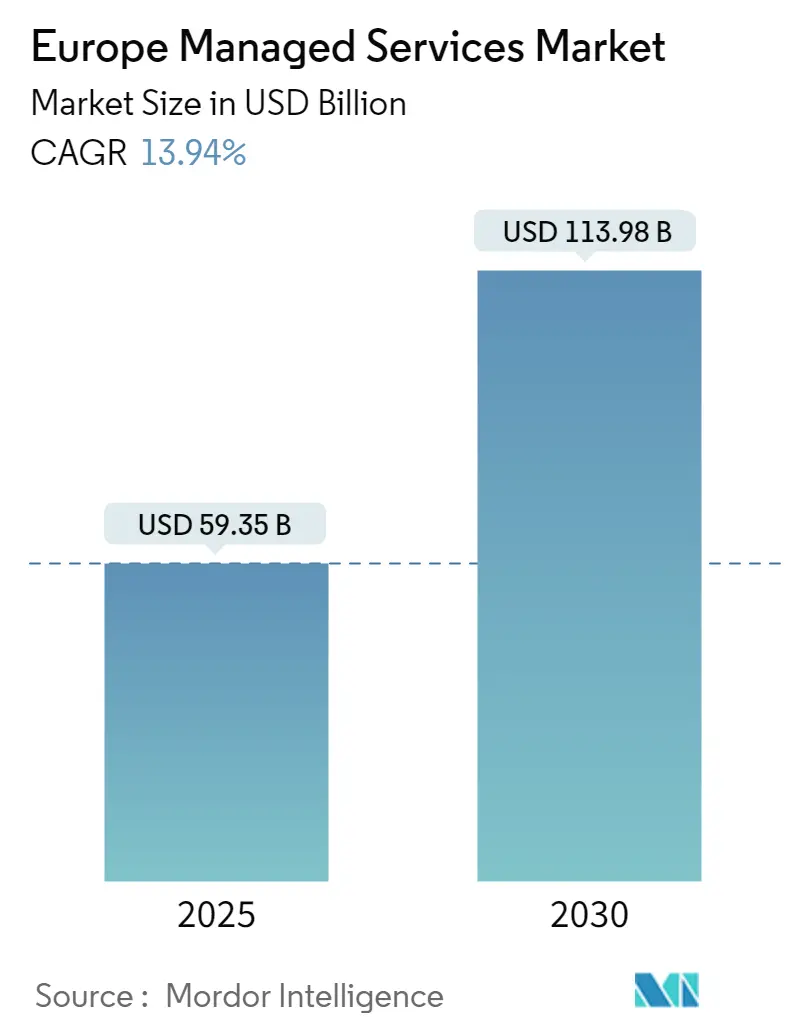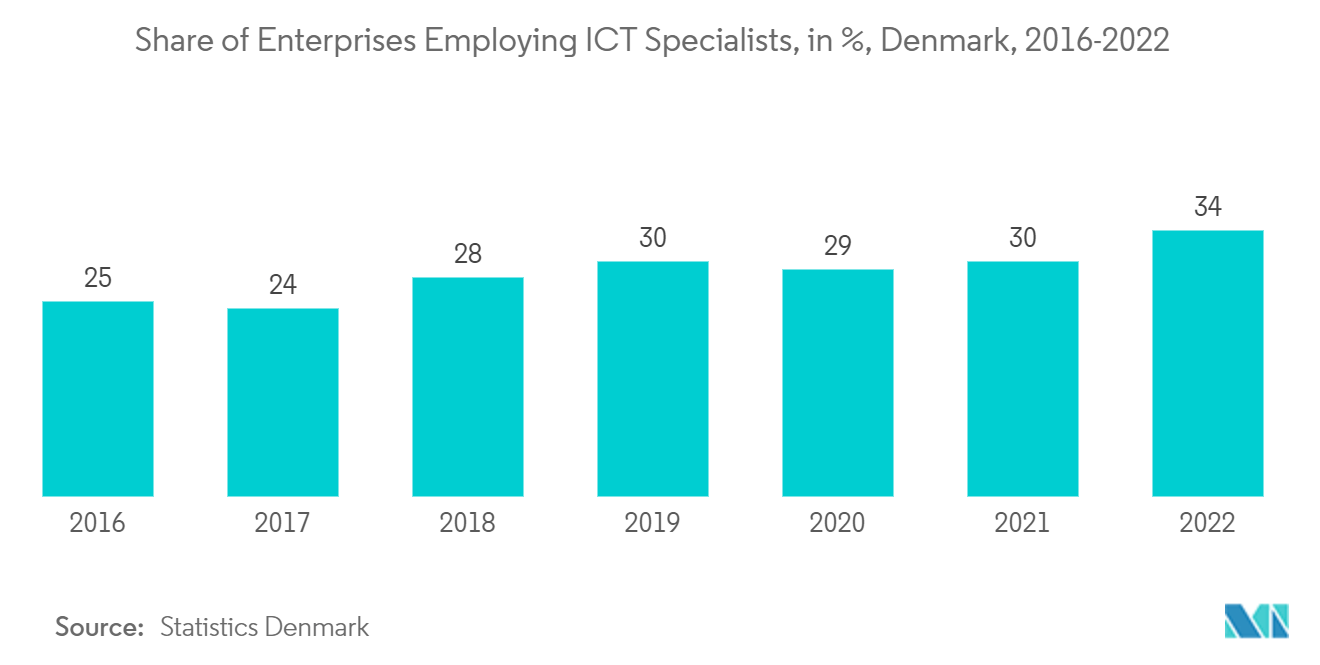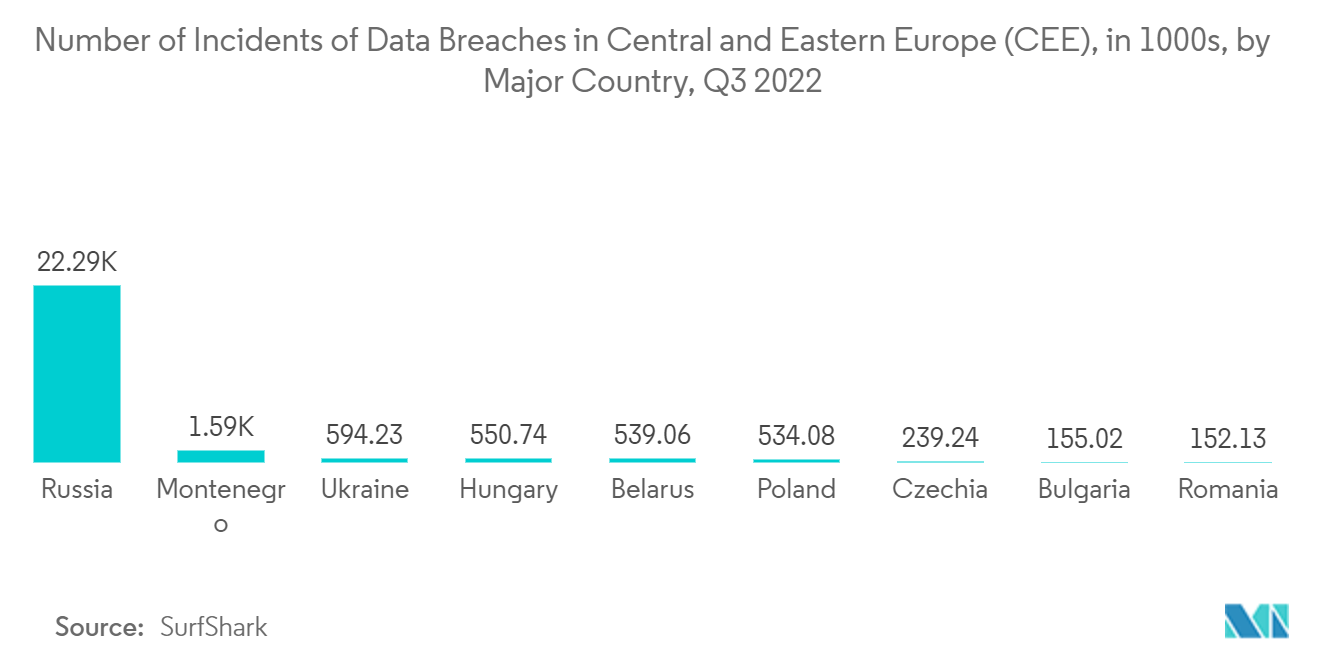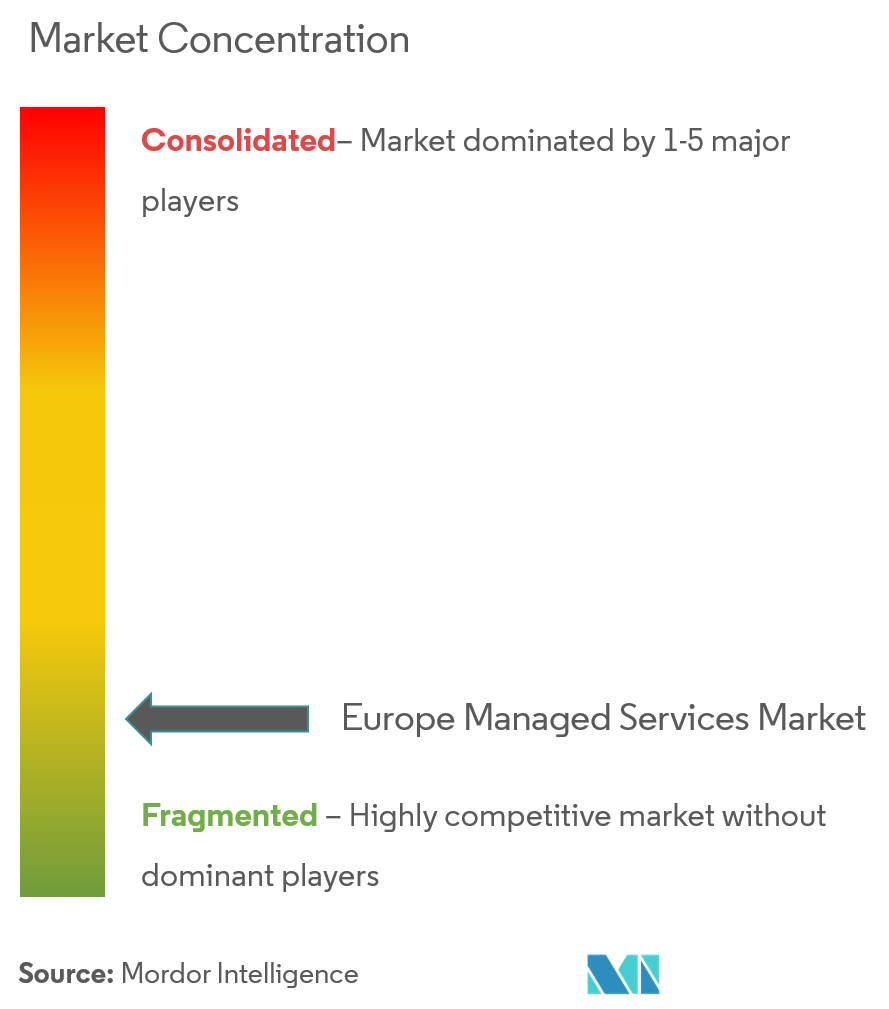Europe Managed Services Market Analysis
The Europe Managed Services Market size is estimated at USD 59.35 billion in 2025, and is expected to reach USD 113.98 billion by 2030, at a CAGR of 13.94% during the forecast period (2025-2030).
- Factors such as the growing adoption of cloud services, growth in cloud diversification, and the willingness of IT companies to minimize capital expenditure and make the most of their IT budgets continue to drive the growth of the studied market.
- Artificial technology and cloud management address various functional business requirements and managed services and assist with the efficient operation of the organization at a low cost without sacrificing the caliber of the work produced. The key market participants are making investments in the creation of new items and the diversification of their product offerings. They are also conducting research and development efforts to provide dependable and affordable services. For instance, in August 2022, Nomura Research Institute, Ltd. (NRI), a leading provider of system solutions and consulting services and system solutions, launched a dedicated managed services room at the NRI Europe Denmark Branch in order to enhance its system for providing managed services in Europe.
- The European region is among the leading automotive manufacturing markets. In recent years, the automotive industry has entered into a period of radical change, with the vehicles being produced expected to be connected, autonomous, shared on-demand, and electric. The emergence of autonomous driving will have challenges, including huge data volumes required for training AI and real-time decision-making systems. Service providers, like Fujitsu, offer solutions that will decrease data volumes and manage them in a distributed fashion, where only the relevant data is collected.
- Furthermore, major players are setting up public cloud setups in Europe to empower businesses. For instance, Microsoft recently announced its plans to deliver two new cloud regions in Germany to equip more organizations and companies in Europe and worldwide to transform them digitally with public cloud solutions. These new regions will offer Microsoft Azure, Office 365, and Dynamics 365 full functionality features, enterprise-grade security, and other features to help customers meet compliance and regulatory requirements.
- Additionally, IoT has forced companies to re-evaluate how customers access information and develop a strategy to best reach them. Millions of new gadgets connect to the Internet every year, making it practically impossible to understand the already complex landscape and the integration challenges and cyber threats provided by many channels. Hence, managed service providers can improve security for each tier of the IoT ecosystem at this point, enabling firms to harness IoT for innovation and stay on the cutting edge of technology by providing qualified resources and round-the-clock support services.
- However, despite the managed services providing excellent benefits, the specific challenges, like reliability concerns, may obstruct the market's growth over the forecast period. The process of hiring an MSP to host critical business infrastructure involves the belief that the providers' business may endure the relationship with them. In case of any failure by the providers to sustain the competition in the market, the enterprises relying upon them may have to entirely replace web hosting, emails, calendars, and other critical pieces of infrastructure, without which it is not possible to conduct business.
- Moreover, the pandemic has also revealed gaps in organizations' disaster recovery plans (DRP) and business continuity plans (BCP). Most of these plans could not address the pandemic, forcing organizations to scramble to transition their IT infrastructure to accommodate a distributed and remote workforce. The pandemic highlighted the importance of monitoring technology and services in detecting security incidents before they cause operational risk. Hence, the post-COVID period is anticipated to drive growth opportunities in the European managed services market.
Europe Managed Services Market Trends
Cloud segment is expected to grow at a higher pace
- With digital transformation in the region, organizations have become dependent on the success of creative applications and extensions that IT could provide. It has become a critical competitive edge for most organizations. Moreover, IT outsourcing has become more than a simple cost-reduction technique with cloud migrations and cloud service options. Therefore, this new form is driven by organizational motivations regarding business growth, customer experience, and competitive disruption.
- The increasing demand for cloud outsourcing indicates that European companies prefer cloud platforms from public sources for data storage purposes. Also, businesses operating over the cloud will likely be concerned about security threats and will eliminate all possible threats by outsourcing IT security services. This way, the demand for expert knowledge of the vendor will be required, along with an easy delegation of responsibilities.
- According to Eurostat, the use of cloud computing among EU enterprises increased significantly in recent years. Industry sources further suggest the increasing adoption of IaaS and SaaS in the European region, which in turn would increase the demand for hybrid cloud in the market. Furthermore, several regional initiatives such as EU's Digital Decade which to expand the use fo cloud-edge technologies among European businesses to 75% by 2030 also favors the studied market's growth.
- Bring-your-own-device (BYOD) and the Internet of things (IoT) have pushed the growth of cloud adoption, as cloud-based solutions are being leveraged primarily to derive value from the data generated by IoT. This is supported by the public, private, and hybrid cloud models. In addition, the legacy IT infrastructure of enterprises may have to rely on the cloud to connect with IoT devices. Besides, organizations realize several drawbacks of public and private cloud services. They are looking for a hybrid approach that provides advantages of both architectures, minimizing the drawbacks in each model. As a result, there is an emerging trend of integrating two or more applications running on private and public systems, i.e., hybrid cloud hosting services.
- Furthermore, the growing adoption of cloud and hybrid IT infrastructure in the European is also evident from the fact that the share of enterprises employing ICT specialists has been growing across various European countries. For instance, according to Statistics Denmark, in Denmark, the share of enterprises employing ICT specialists increased to 34% in 2022, compared to 25% in 2016.
Managed Security Account for Significant Market Share
- To maintain a competitive edge, organizations across Europe, irrespective of their sizes, increasingly rely on managed service providers to ensure technology usage to transform and scale businesses. Managed security service providers are adding value to their portfolio of offerings by providing the right expertise, solutions, and pricing models. Managed security service is an emerging field in the dynamic business space of the region. Service providers are setting up managed security operations centers (SOC) to deliver security and support services. Most service providers deploy their own unified security management platform for customers to provide security information and event management) and other monitoring solutions (SIEM).
- The growing cyber security threats due to the increase in the development of technologies have led the government to invest in cyber security and MSSP. For instance, according to AAG IT Services & Cyber Security, in 2022, about 39% of enterprises in Europe reported suffering a cyberattack.
- Fully managed to host services, including server installations and setup, approved software installations according to customer requirements, security monitoring, software updates and management, data backup and protection, and a slew of other services. Many enterprises in Germany, especially startups and SMEs, are looking for such solutions. These services offer the opportunity for SMEs that need more capital to keep and maintain their servers on-site, need an appropriate IT team, or are time-constrained due to the demands of their business operations.
- The rise in data breaches in the region is expected to drive the managed security services and enable managed security vendors to develop new products to capture the market share. For instance, according to tour shark, with over 22.3 million data breaches in the third quarter of the current year, Russia led all of Central and Eastern Europe (CEE) countries. Ukraine and Montenegro came in second and third, respectively.
- To empower the thriving startup ecosystem in the country, many French majors, like Dassault Systems, are offering packaged solutions (software-as-a-service (SaaS), platform-as-a-service, PaaS, and infrastructure-as-a-service (Iaas)) that can be easily deployed with tailored offerings for startups to augment growth. The French government decided to use the services of outsourcing non-critical data to an external cloud provided by Orange Business Services after realizing the benefits of using the cloud, which is perfectly suited to capacity fluctuations (thereby empowering the government with the flexibility required to implement new services more quickly).
Europe Managed Services Industry Overview
The Europe managed services market is fragmented as the market studied is dominated by international players with a strong client base. Additionally, companies are employing powerful competitive strategies to sustain themselves in the market and retain their clients, intensifying competitive rivalry. Key players are Fujitsu Ltd, IBM Corporation, Cisco Systems, etc.
- January 2024: Business ISP and managed service provider Evolve has become the latest provider to hop onto MS3‘s new 10Gbps capable Fibre-to-the-Premises broadband network in the North of England, aiming to reach 535,000 UK premises by the end of 2025. An unspecified investment from Asterion is backing MS3 and has covered 158,779 premises passed (119,139 RFS) and is rising fast. Evolve’s new partnership with MS3 allows them to leverage MS3’s XGS-PON network to bring new solutions to businesses in the East Riding and Lincolnshire regions for the first time.
- December 2023: BT and Netskope, a player in Secure Access Service Edge (SASE), announced a partnership to bring Netskope's market-leading Security Service Edge (SSE) capabilities to BT's global customers. The partnership follows several large customer implementations where the two companies have collaborated to meet the security and access needs of large enterprises successfully. BT's data shows that hybrid working is now a requirement for 76% of global workers, driving a requirement for more agile, secure connectivity.
Europe Managed Services Market Leaders
-
Fujitsu Ltd
-
Cisco Systems Inc.
-
IBM Corporation
-
AT&T Inc.
-
HP Development Company LP
- *Disclaimer: Major Players sorted in no particular order
Europe Managed Services Market News
- November 2023: Netskope, a player in Secure Access Service Edge (SASE), and Telstra International, the global arm of telecommunications and technology company Telstra, today announced the expansion of their partnership to enable Telstra to deliver fully managed Netskope cloud-native Secure Access Service Edge (SASE) —including Zero Trust Network Access (ZTNA) services—to organizations globally. Customers worldwide use Telstra's managed security services to help address the changing needs of the digital workplace and mitigate the ever-evolving cyber threats landscape.
- In February 2023, Infosys, a leading provider of next-generation digital services and consulting, entered into a strategic collaboration with ng-voice GmbH, a provider of cloud-native IP Multimedia Subsystem (IMS) solutions. Through this, Infosys will provide systems integration services for ng-voice, facilitating telecom operators with digital capabilities to deploy containerized and cloud-native network solutions across Europe. Building on this, both companies also aim to provide managed services to support the network solution while delivering personalized customer experiences and fostering innovation.
Europe Managed Services Industry Segmentation
The emergence of managed services is aiding in meeting the needs of a wide variety of businesses throughout Europe. In the region, the telecommunication providers are focusing on security services, owing to European regulations. Furthermore, the region has a strong automotive and manufacturing sector, and in addition, emerging applications, like cloud-based solutions, are expected to do significantly well during the forecast period.
The Europe managed services market is segmented by deployment (on-premise and cloud), by type (managed data center, managed security, managed communications, managed networks, managed infrastructure, and managed mobility), by enterprise size (small and medium enterprises and large enterprises), by end-user vertical (BFSI, manufacturing, healthcare, retail), and country (United Kingdom, Germany, France, and Rest of Europe). The market sizes and forecasts are provided in terms of value (USD) for all the above segments.
| By Deployment | On-premise |
| Cloud | |
| By Type | Managed Data Center |
| Managed Security | |
| Managed Communications | |
| Managed Network | |
| Managed Infrastructure | |
| Managed Mobility | |
| By Enterprise Size | Small and Medium Enterprises |
| Large Enterprises | |
| By End-user Vertical | BFSI |
| Manufacturing | |
| Healthcare | |
| Retail | |
| Other End-user Verticals | |
| By Country | United Kingdom |
| Germany | |
| France | |
| Rest of Europe |
Europe Managed Services Market Research FAQs
How big is the Europe Managed Services Market?
The Europe Managed Services Market size is expected to reach USD 59.35 billion in 2025 and grow at a CAGR of 13.94% to reach USD 113.98 billion by 2030.
What is the current Europe Managed Services Market size?
In 2025, the Europe Managed Services Market size is expected to reach USD 59.35 billion.
Who are the key players in Europe Managed Services Market?
Fujitsu Ltd, Cisco Systems Inc., IBM Corporation, AT&T Inc. and HP Development Company LP are the major companies operating in the Europe Managed Services Market.
What years does this Europe Managed Services Market cover, and what was the market size in 2024?
In 2024, the Europe Managed Services Market size was estimated at USD 51.08 billion. The report covers the Europe Managed Services Market historical market size for years: 2019, 2020, 2021, 2022, 2023 and 2024. The report also forecasts the Europe Managed Services Market size for years: 2025, 2026, 2027, 2028, 2029 and 2030.
Our Best Selling Reports
Managed Service Provider (MSP) in Europe Industry Report
Statistics for the 2025 Europe Managed Services market share, size and revenue growth rate, created by Mordor Intelligence™ Industry Reports. Europe Managed Services analysis includes a market forecast outlook for 2025 to 2030 and historical overview. Get a sample of this industry analysis as a free report PDF download.







